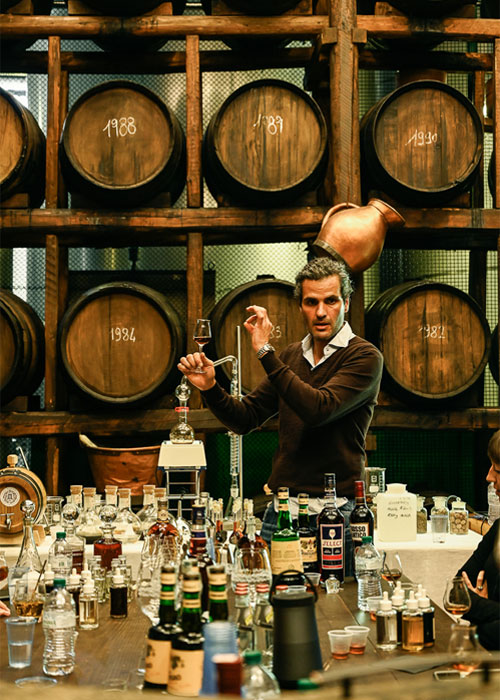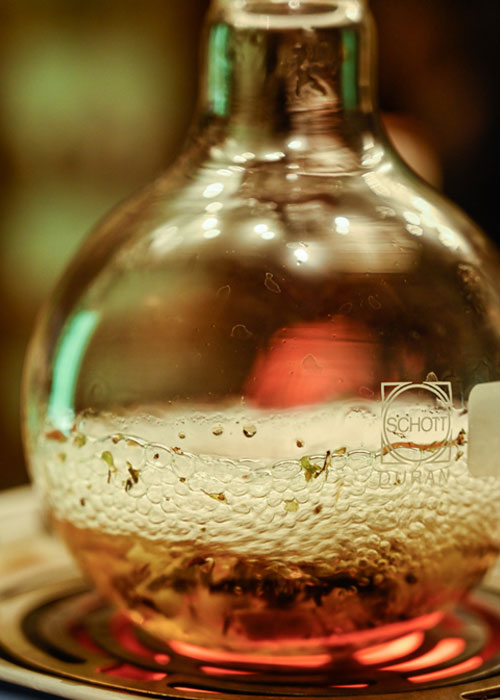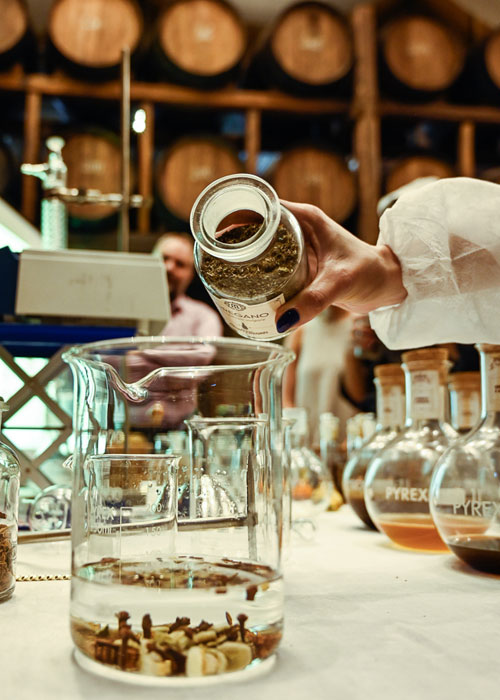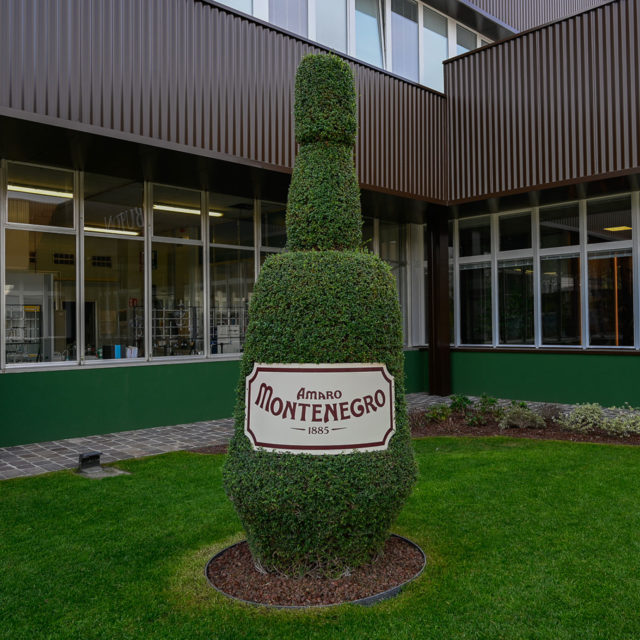“This is the magic behind Amaro Montenegro — starting from something disgusting and getting something beautiful,” Matteo Bonoli says, gazing at a beaker of dark, viscous liquid in his hand. The aroma is complex, syrupy, and redolent of molasses. But this is a trick of the senses: Even the tiniest of sips floods the mouth with an unrelenting, nose-wrinkling bitterness that lingers and lingers. This is wormwood, and to the untrained palate, it is truly disgusting.
Labeled fittingly as the “Bitter & Herbaceous” essence, this is one of the six mother extracts that are blended together to make Amaro Montenegro, an Italian bitter liqueur. I am with Bonoli, the master herbalist for the brand, at the Gruppo Montenegro facility outside Teramo, Italy, where these essences are produced. Here, 35 botanicals are boiled, macerated, and distilled into base notes with distinct flavor profiles — Bitter & Herbaceous, Fresh & Balsamic, Sweet & Roasted, Warm & Tropical, Spicy & Floral, and Fruity & Vegetal.
Like many Italian amari, Amaro Montenegro has used the same recipe since it was first developed in 1885. And like many Italian amari as well as other legacy liqueurs from around the world, this recipe is a closely guarded secret — so closely guarded that I am only the third journalist allowed a pungent peek behind the curtain at the Teramo production plant.
The Guards of Montenegro
As master herbalist, Bonoli, who has been with the company for nearly 10 years, is the steward of the recipes for Amaro Montenegro and the company’s other spirits, including Select Aperitivo and Coca Buton, a Slimer-green liqueur made from coca leaves. Dressed in moto jeans and a leather jacket, curly hair pulled back in a ponytail, Bonoli could conceivably be played by Antonio Banderas were there a market for films based on the lives of food scientist PhDs. Today, he is my tour guide — primarily because he has to be. This building is normally off limits, and the list of employees authorized to access the plant (and who are fluent in English) is short.

The facility is a nondescript building that looks like it’s been plucked from an office park in Cupertino, Calif., and dropped into the rolling hills of Abruzzi. As we open the door, we’re immediately hit by an herbaceous, spicy aroma. Marcello Chiarini, the plant coordinator, greets us and escorts us into the locker room, where we remove our jewelry, don disposable lab coats and hairnets, and trade our sneakers for sensible factory shoes with strong Weekend Dad vibes.
Exactly six men work at Amaro Montenegro’s Teramo location, and the rookie among them has been there for 18 years. Doors with keypads are everywhere, and Chiarini explains that the mens’ jobs are highly compartmentalized; he is the only person allowed access to all areas. He pulls out his phone, showing live security camera footage from a locked room. It is empty except for three large sacks — coca leaves. He’s like a proud parent sharing images from his baby monitor, except instead of an infant it’s a Schedule II narcotic.
Cloak-and-Dagger Distillation
As we cross the factory floor, the smells intensify, layering and wafting seductively from around corners. Bonoli shepherds us into a refrigerated storage room, where deep shelves stretch to the ceiling. On the shelves are hundreds of identical white sacks, piled in four-foot-high stacks. Each stack has a cryptic piece of paper taped to it: “ERBA AROMATICA” followed by a five-digit code. All other identifying information has been removed.
Bonoli explains that these herbs, the raw materials of Amaro Montenegro, are subject to agricultural cycles and supply chain whims. When the 2004 tsunami hit Sri Lanka, Gruppo Montenegro was unable to source the cinnamon that the recipe requires. As a precaution, they now stock a two-and-a-half-year supply of every ingredient.
As we step out of the cold storage room, I catch a whiff of warm spice. “Cloves?” I guess. Bonoli shrugs theatrically. We head toward the maceration tanks and stills, moving in and out of ribbons of scents. We walk by a jumpsuit-clad worker opening a sack and are thrown headfirst into an aromatic cloud of juniper bush. We pass an open doorway and are suddenly steeping in a pot of chamomile tea. (It’s a red herring: Bonoli is careful to note that the facility also processes botanicals for Gruppo Montenegro’s other spirits and line of teas.)

Artemisia, a genus of herbaceous plants with many culinary and medicinal uses, is being prepared for boiling. Bonoli steers me toward four open sacks of various varieties — small absinthe, valais wormwood, Roman wormwood, and genepy. He scoops up a handful from one, encouraging me to do the same. I bring my nose to my palm. The smell is bitter, dusty, medicinal, and very green.
Approaching the tour’s conclusion, we round a corner and are greeted by the bracing aroma of Vicks Vaporub; the Fresh & Balsamic essence is coming off the still. Bonoli extracts us a sample. At 80 percent alcohol, it’s only suitable for lip wetting, but I detect flavors of bay leaf and nutmeg, like Thanksgiving on a crisp morning. He cuts it with water, and it turns cloudy like pastis, indicating that it’s rich in essential oils.
The Teramo plant is responsible for producing all the essences that comprise Amaro Montenegro except for one, il premio. Bonoli speaks of it in hushed, reverent tones. Each bottle contains only one drop of the premio, which is produced at the company headquarters in Bologna, but without it, it wouldn’t be Montenegro. Its five ingredients are, naturally, top secret, but as I smell a dab applied to my wrist with an eye-dropper, I suspect they simply melt down Creamsicles.
Why All the Secrecy?
Of course, Amaro Montenegro isn’t the only amaro or bitter liqueur to keep its recipe behind closed doors. Amaro Ramazzotti has been made with the same “secret” blend of 33 herbs and roots since its creation in Milan in 1815. Fernet-Branca, produced in Milan since 1845, shares only a handful of its 27 components with the public, and those five ingredients are prepared by the company’s CEO in a locked room. Campari’s recipe, rumored to contain up to 80 ingredients, is such a closely guarded secret that only three individuals know it, and their identities are protected, too.
Even Germany’s hard-partying Jägermeister is tight-lipped about the 56 botanicals, fruits, and herbs in its formula.

Asked about the reasons behind Amaro Montenegro’s extreme stealth — which seems especially unnecessary in this facility, which is closed to the public and where the six employees are all lifers — Bonoli sighs. “I don’t know,” he says. He tells a story of the night before in Rome, where he went for a drink at The Court, a cocktail bar across from the Colosseum:
“When the bartender found out where I worked, he told me that he didn’t believe we actually started from botanicals. He accused us of using powders and flavorings,” Bonoli says. “This is what we’re up against, but it is a problem of our own making. We are so secretive about how Amaro Montenegro is made that people start believing we have something to hide.”
“In Italy,” he continues, “we have a saying—‘San Tommaso che non ci crede se non ci mette il naso.’ It means, ‘Saint Thomas doesn’t believe something unless he can put his nose right into it.’”
The expression refers to Saint Thomas, one of the Twelve Apostles of Jesus, who is commonly known as “Doubting Thomas” for not believing in the resurrection until he saw Jesus’s wounds. Had that Roman bartender been able to visit Montenegro’s processing plant, to wander the thickly scented rooms and put his nose right into the sacks of aromatic herbs, he’d likely be a believer.
Still, it’s Amaro Montenegro; with it and any other liquid legend, it’s almost as if the secret ingredient is secrecy itself.
